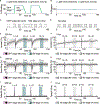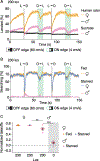Visual threat avoidance while host seeking by Aedes aegypti mosquitoes
- PMID: 40112001
- PMCID: PMC12077400
- DOI: 10.1016/j.celrep.2025.115435
Visual threat avoidance while host seeking by Aedes aegypti mosquitoes
Abstract
The mosquito Aedes aegypti infects hundreds of millions of people annually with disease-causing viruses. When a mosquito approaches a host, the host often swats defensively. Here, we reveal the mosquito's escape behavior during host seeking in response to a threatening visual cue-a newly appearing shadow. We found that reactions to a shadow are far more aversive when it appears quickly versus slowly. Remarkably, mosquitoes evade shadows under very dim light conditions. Knockout of the TRP channel compromises the ability of mosquitoes to avoid threatening shadows, but only under high light conditions. Conversely, removing two of the five rhodopsins normally present in the compound eyes, Op1 and Op2, diminishes shadow aversion, but only under low light. Upon removal of a threatening visual cue, mosquitoes quickly re-initiate host seeking. Thus, female Aedes balance their need to host seek with visual threat avoidance by rapidly transitioning between these two behavioral states.
Keywords: Aedes aegypti; CP: Neuroscience; TRP channel; avoidance; behavior; host seeking; mosquito; opsin; rhodopsin; shadow; vision.
Copyright © 2025 The Author(s). Published by Elsevier Inc. All rights reserved.
Conflict of interest statement
Declaration of interests The authors declare no competing interests.
Figures







References
-
- Montell C, and Zwiebel LJ (2016). Mosquito sensory systems. Adv. Insect Physiol 51, 293–328.
-
- Barredo E, and DeGennaro M (2020). Not just from blood: mosquito nutrient acquisition from nectar sources. Trends Parasitol. 36, 473–484. - PubMed
-
- Priyadarshana TS, and Slade EM (2023). A meta-analysis reveals that dragonflies and damselflies can provide effective biological control of mosquitoes. J. Anim. Ecol. 92, 1589–1600. - PubMed
MeSH terms
Substances
Grants and funding
LinkOut - more resources
Full Text Sources
Other Literature Sources
Miscellaneous

